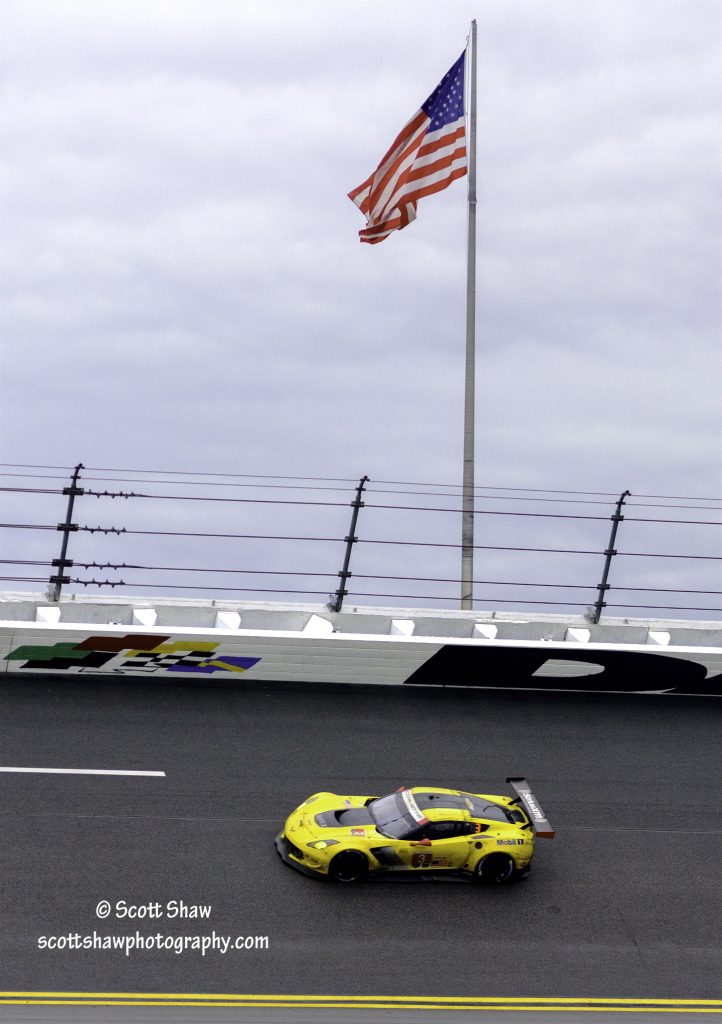One last image from the Rolex 24 at Daytona International Speedway. The group I was with went into the Corvette garage and talked to a few team members. While others were talking, I sat on the floor and took the above image.
I would have liked to ask someone to block out the hotspot just above the Michelin Man logo, but thought that would be a little rude.
It was interesting hearing about the tires. Teams do not have enough rims to last the entire 24 hours, so Michelin has a facility set up to swap tires on rims. When a car pits, the team takes the worn tires off the car and to the Michelin facility. The rims get fresh tires and return to the pit box for the next pit stop. Corvette Racing had two people dedicated to transporting tires to and from the Michelin facility for the entire 24 hour race.
Do that for all the teams, for 24 hours, and that adds up to one heck of a lot of tires!
 Here is another image from the Rolex 24 at Daytona International Speedway. Watching cars go round and round does not present many ways to vary the composition. I was walking around the track and noticed the flagpole and the Daytona logo and thought those would add some interest.
Here is another image from the Rolex 24 at Daytona International Speedway. Watching cars go round and round does not present many ways to vary the composition. I was walking around the track and noticed the flagpole and the Daytona logo and thought those would add some interest.
I started with some slower shutter speeds such as 1/100. Looking at the image on the monitor on the back of the camera to check the image, I had to keep increasing shutter speed until I reached 1/2500. Because it was overcast, I had to bump my ISO up to 1000. I took several images that looked good on the monitor and went elsewhere.
If you zoom in on the image, you can see that the corvette is still soft. What I took away from this is that if the shutter speed looks good on the camera monitor, take several more images with a faster shutter speed, just in case.
Besides the sky being so gloomy, the above image is another case where I just missed the shot.
Daytona International Speedway: N29 10 46.85 W81 04 14.91
I had the opportunity to attend the Rolex 24 at Daytona International Speedway with a member of the Corvette Racing management team. We had pit passes which allowed us to get right next to the track.
The race was my first foray into “action photography”. As you can tell from all the other images on this website, I usually have my camera mounted on a tripod, use long shutter speeds, high f/stops and a cable release. None of those this weekend!
Of course, the first thing you need to do at a race is a panning shot. Above is the best of several dozen attempts. I would shot in continuous mode and track the car as it went by. I used the continuous-servo auto-focus mode on my Nikon and the Auto-Focus-On button on the back to keep focus as the cars passed. The Auto-Focus On button allows the camera to continuously focus while the shutter release button is fully depressed. After doing this the first day I really came to love the Auto-Focus On button instead of relying on depressing the shutter release button halfway to focus.
Because the intent of a panning shot is to keep the subject in focus and blur the background, I used f/4.0 on my 70-200mm zoom lens to limit my depth of field. I then used various shutter speeds to see how they affected the image. What I determined is that the longer the shutter speed, the longer you had to track the car. The longer you had to track the car, the more time there is to blur the subject because of failing to track the car at the right speed.
I ended up using 1/100 seconds for the above image. I have other images where I froze the cars motion and those required a shutter speed of 1/2500. Compared to 1/2500, 1/100 is a lifetime!
The red, white, and blue seats in the background make for good blur and an interesting background.
Daytona International Speedway: N29 11 05.07 W81 04 25.32



